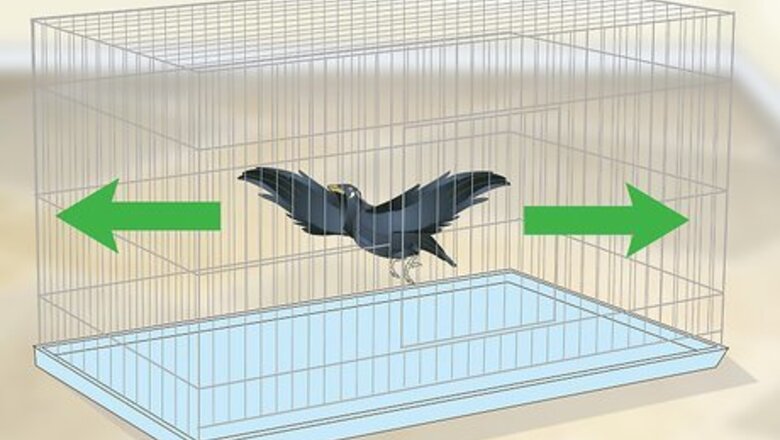
views
- Purchase a cage that's at least twice as tall and wide as your new bird. Make sure that the bars are properly spaced out and made of sturdy material, like stainless steel.
- Put the cage in a room with a pleasant view. The cage shouldn't be near screenless windows or doors or placed in rooms that get really hot or cold.
- Set paper towels or newspaper along the bottom of the bird cage so you don't have a difficult time cleaning up.
- Fill the cage with supplies like perches, a bird bath, food/water bowls, and safe toys.
Cage Requirements
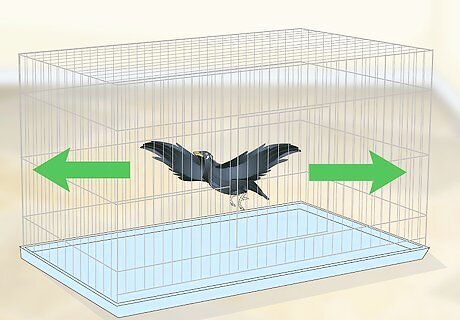
Pick a cage roomy enough for your bird. You definitely don't want your bird to be cramped in a cage that is too small. Choose a cage that is at least twice as tall and twice as wide as the wingspan of your bird. Get the most spacious cage possible that will fit well into your home. Many cages are species-specific. For example, a finch usually does best in a wide cage where they have room to fly. Many birds, like parrots and cockatoos, feel stressed in a rounded cage, so choose a square or rectangular cage to avoid stressing your pet.
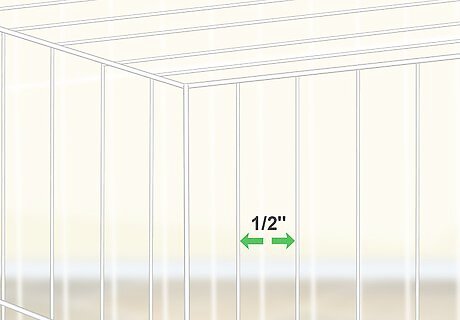
Ensure the bars are appropriately spaced. Different species require cages with differently spaced bars, such as ½ in (2.54 cm) spacing for parakeets and cockatiels. Don’t overlook the spacing, as a bird can get their head stuck in bars that are too far apart for their size, or may even escape and injure or kill themselves. Generally, for small birds such as finches, canaries, and lovebirds, you want bars that are spaced no more than 0.63 inches (1.6 cm) apart. For cockatiels, lories, and Senegals, the bars should be 0.5 inches (1.3 cm) to 0.88 inches (2.2 cm) apart. Larger birds like African Greys, macaws, and cockatoos should have bars that are 0.75 inches (1.9 cm) to 1.38 inches (3.5 cm) apart. Do an internet search or ask a pet shop associate what the appropriate bar spacing is for the species of bird you have.
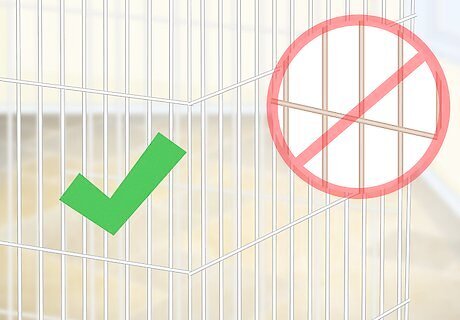
Choose a cage made from a sturdy material. Bird cages are generally made out of wire, metal, or stainless steel. Some cages may rust or lose their finish over time, so choose stainless steel if you want something that will last for years. Avoid cages containing lead or zinc, which can be harmful to your bird.
Cage Location
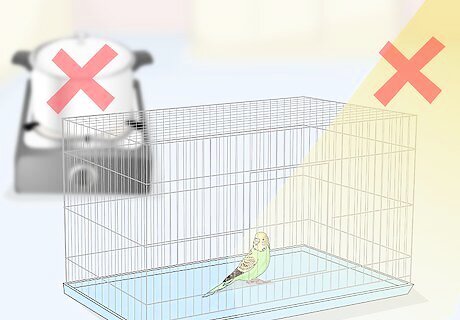
Protect the cage from extreme temperatures and direct sunlight. Keep the cage away from the kitchen to protect your pet from hazards like extreme changes in temperatures. Don’t place the cage in an area where it will get direct sunlight, which can cause your bird to get too hot. Fumes from certain non-stick pans can make your bird ill or even kill them. Keep your bird far from the kitchen in a well-ventilated area if you plan to use these pans. If you are in a cold-weather climate, keep your bird in an area away from cold spots and drafts such as by doors and windows. Exposure to the cold could be dangerous for your bird's health.
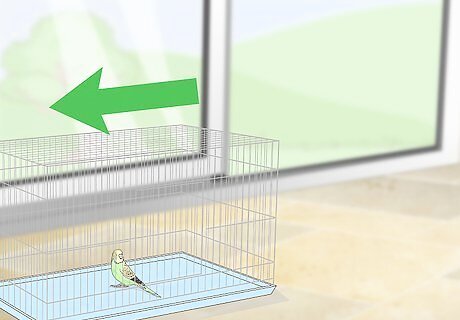
Keep the cage away from exterior doors and windows without screens. To prevent escape, you should put your bird cage in a room without an exterior door. All windows in the room should have secure screens as well. Be sure the bird cannot reach any blind cords on the windows through the cage with their feet. This keeps them from getting tangled or chewing on and ingesting parts of the cord, both of which could cause injury.
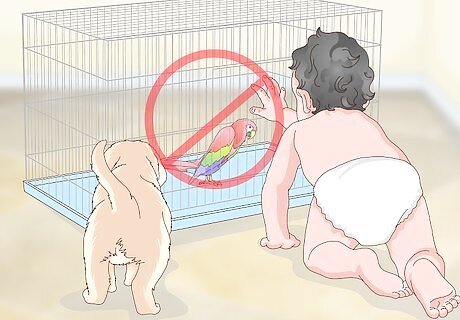
Restrict access to the cage from children and pets. Be sure that young children and other pets in the home don’t have access to the cage, as they may unintentionally stress or harm your bird. It’s also important to keep the cage away from fish tanks, which pose a drowning risk should your bird get wet and be unable to fly out.

Put the cage in a room with an easy-to-clean floor. Choose a room with linoleum, tile, or vinyl flooring, rather than carpet, if possible. Otherwise, place heavy plastic floor protectors (such as those used under desk chairs) underneath the birdcage. That will make it easier to sweep up and clean your bird's living space on a regular basis.
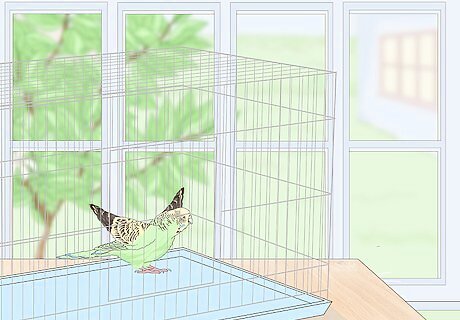
Give your bird a nice view. If your bird will be spending most of it’s time in the cage, rather than roaming your home, you should provide your bird with interesting things to look at. Place your bird cage near a shaded window to allow them to look out at the yard or garden. You can also put pet-safe plants near your bird’s cage or situate them so they have a view of an outdoor bird feeder. Many birds find a sense of security when their cage is placed near a wall, so consider situating the cage this way.
Cage Preparations
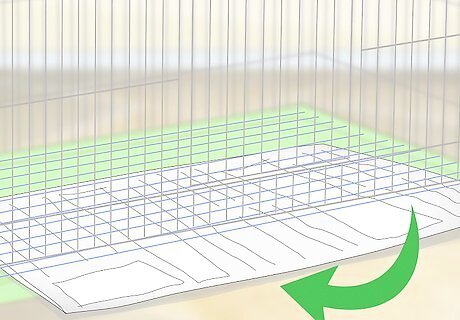
Line the bottom of the bird cage. Place newspaper or paper towel along the bottom of the cage to catch droppings and make for easier clean up. Cages with grates placed a few inches above the bottom of the cage to prevent birds from accessing their waste are recommended. Change the lining every other day. Avoid using cat litter, sand, wood shavings, or other materials in the bottom of the bird cage.

Place food and water bowls in the cage. Most pet stores sell dishes that will hang from the side of the cage and are made for a bird to perch on. These allow for easy refills and may be more convenient than placing a bowl on the bottom of the cage. You can also use a water bottle in place of or in addition to a water dish.

Add a bird bath. Birds have many opportunities to bathe in the wild, so be sure to provide them with an opportunity to bathe in their cage. Choose a short, heavy, sturdy bowl, fill it with lukewarm water, and place it on the floor of the cage. Alternatively, you can purchase a bird bath that hangs from the side of the cage to prevent moisture from gathering on the floor of the cage.
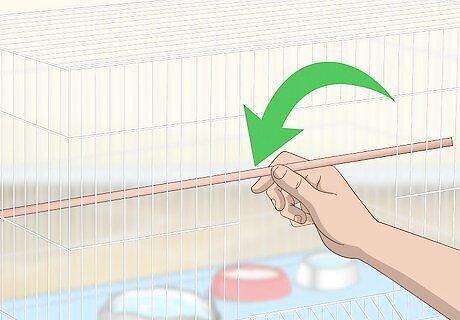
Include perches for your bird. Birds need perches and will spend a lot of their time enjoying them. Provide your bird with perches of different heights, contours, and textures, and place them at varying heights within the cage. For example, place a thick wooden perch horizontally in the cage as well as a thin rope perch positioned at an angle.
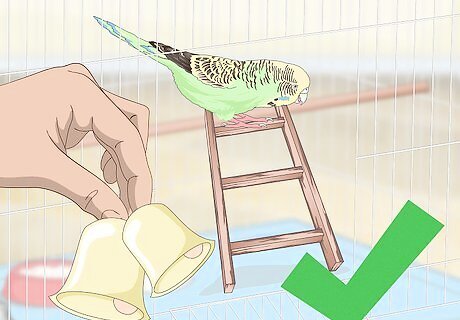
Put safe toys in the cage. Toys are essential for your cage, as they provide your bird with stimulation and keep them from becoming bored. Good toys for your bird include mirrors, ladders, swings and bells. You can also put wooden, plastic, or rope toys in the cage for your bird to play with and chew on. Wash your bird’s toys often with mild soap and warm water. Rinse them thoroughly and allow them to air dry completely before returning them to the cage.
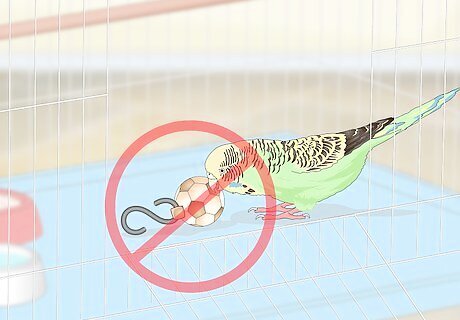
Avoid dangerous toys. Dangerous toys include toys made from dyed leather and those with “S” hooks or small, removable parts that might be swallowed. "Jingle” style bells are also unsafe because your bird’s toes or beak can become trapped in the openings. Avoid overloading the cage with toys. Rotate them out regularly instead so they keep your bird’s interest.




















Comments
0 comment